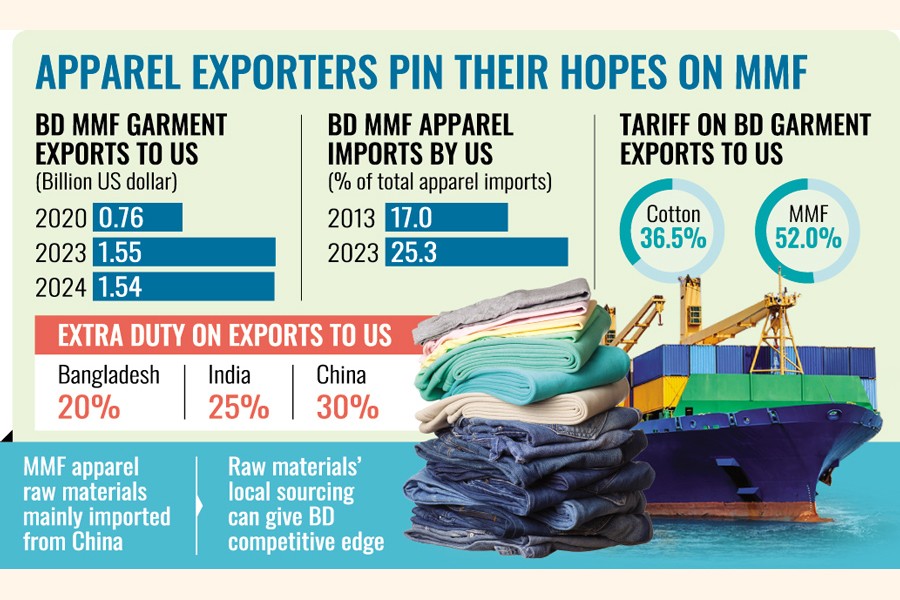Prospect bright for Bangladeshi MMF-based RMG exports to US, say exporters

Published :
Updated :

Bangladeshi manmade fibre (MMF)-based garment exports to the US, which remained almost static during the last two years, will get a boost amid the duty tension among the major producing countries, provided local challenges are addressed, industry insiders said.
They said now is the right time to invest in the backward linkage textile sector, especially MMF-based garment manufacturing.
Bangladesh is currently in an advantageous position with a 20 per cent additional duty for exporting to the US and can grab a larger share of work orders shifting from China and India, they also said.
They further added Vietnam is not increasing its garment production capacity, while Bangladesh has the capacity and can further enhance it if the required policy support is provided.
According to data compiled by the Bangladesh Garment Manufacturers and Exporters Association (BGMEA), Bangladesh exported MMF-based garments worth $1.54 billion to the US in 2024, which was almost the same - $1.55 billion - in 2023.
Such exports were only $764.92 million in 2020.
Abdullah Hil Nakib, deputy managing director of Team Group, told The Financial Express MMF-based apparels account for $1.2-1.3 billion of the $7.50 billion Bangladeshi garments exported to the US on average.
Most of the required raw materials to make such clothes are imported mainly from China, he said.
Due to the trade and duty war between the US and China, orders from the latter will shift to other destinations, he said.
"Now we have a scope to choose and go for high-value-added items made with MMF."
He said his company's exports of MMF apparel items like jackets and outerwear have been increasing for the last couple of years.
Nakib, however, said MMF garments are mostly exported to the European Union (EU).
The EU imposes one regulation after another, including ESG and other due diligence requirements, and this encourages local exporters to diversify their destinations, he said.
Though sourcing raw materials from China may have some disadvantages for exporting products to the US, he said it is high time Bangladesh prepared itself by handling the least developed country (LDC) graduation challenges.
The US cut the additional duty on Bangladesh's exports to 20 per cent from 35 per cent, which is now equal to, or on a more equal footing with, the major competitors.
The rate is lower than China's 30 per cent and India's 25 per cent.
Bangladeshi garment exports to the US will face tariffs of 36.5 per cent and 52 per cent for cotton-based and MMF-based items, respectively.
The rates include 20 per cent reciprocal tariff on top of the existing 16.5 per cent and 32 per cent tariffs, respectively.
Shovon Islam, managing director of Sparrow Group, said Bangladesh could gain a competitive edge in MMF garment manufacturing if raw materials are sourced locally.
Sayeed Ahmed Chowdhury, director at Square Denim, said they mostly blend MMF with other materials, such as cotton, due to the absence of local raw materials despite huge demand.
He, however, said a good number of entrepreneurs are investing in the MMF segment to grab a share of the growing global demand.
Bangladesh Textile Mills Association (BTMA) President Showkat Aziz Russell said following the successful reciprocal tariff negotiations with the US, Bangladesh is now in a stronger position.
As a result, local exporters are receiving more queries from buyers, he said.
"There is optimism about future business, and we want to invest further. Now is the high time to invest in the textile sector," he added.
BTMA former president A Matin Chowdhury, however, stressed diversification in the textile sector to manufacture blended, as well as MMF- and non-cotton-based, yarns and fabrics to sustain business in the long run and face the emerging challenges.
According to industry insiders, Bangladesh's synthetic yarn industry is small and cannot meet the domestic demand for MMF yarns.
That is why the country imports most of the manmade yarns and fibres used in apparel exports, they said.
Till 2023, Bangladesh had 19 synthetic spinning mills, including eight acrylic ones, they added.
The synthetic yarn industry commonly imports pellets for mixing and blends synthetic fibres with natural ones to create blended yarns.
Insiders expect that the demand for such yarns will increase in the future.
To meet this demand, they are working on increasing the domestic supply of MMF yarns and seeking the required policy support from the government.
With respect to fibre types, cotton garments account for the majority of US imports by value and share, although the product mix between cotton and synthetic garments changed gradually between 2013 and 2023, according to a United States International Trade Commission report.
In 2013, MMF garments made up 17.0 per cent of the US apparel imports from Bangladesh. By 2023, the share grew to 25.3 per cent, the report said.
Munni_fe@yahoo.com


 For all latest news, follow The Financial Express Google News channel.
For all latest news, follow The Financial Express Google News channel.